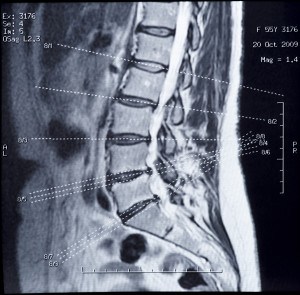Adjusters handling claims involving low impact, minor property damage auto accidents should examine sore back claims closely, according to B. Lee Wertz Jr. a partner at the Houston-based law firm of Harrison Bettis McFarland.
Wertz spoke during a boot camp session on the subject at the Risk Management Society conference in Denver last month.
Back claim evaluations can be difficult with impacts below 10 mph, he said. There is the natural skepticism coupled with the fact that not every accident can cause a herniated disc.
 When reviewing an MRI report, he recommended adjusters be on the lookout for:
When reviewing an MRI report, he recommended adjusters be on the lookout for:
- Hypertrophy which is swelling of tissue caused by pain, not trauma.
- Desiccation, the drying out of discs, typically reduces their flexibility and height.
- Osteophytes, also known as bone spurs.
- Narrowing of the foramen, where nerve roots don’t have enough room to pass through the foramen.
According to Wertz, the first three have nothing to do with trauma and are typically due to degenerative changes.
He also recommended adjusters avoid referencing a herniated disk as an injury. He suggested using the term “medical condition” instead. That’s because if the case goes to a jury, they will pick up on it.
The Texas attorney also recommended using photos early and often during a claim investigation and/or lawsuit.
As far as experts, Wertz recommended using a forensic radiologist. This type of specialist can determine evidence of acute trauma, swelling or bruising, and whether a fracture was recent or long term. They can also measure disc bulge size.
Using an orthopedic surgeon, on the other hand, can hinder a case. Orthopedists don’t typically look at injury causes, just treatment and symptoms.
Another type of expert, a biomechanical engineer, can examine the movement of a body and the forces exhibited upon it, but some judges aren’t fond of them because they don’t clearly understand the dynamics behind their research.
According to Wertz, adjusters should pay particular attention to claims involving lumbar disks. That’s because they don’t move much. Science says a speed above 21 miles per hour is needed for the likelihood of a disc herniation. If a claimant alleges damaged discs due to a low impact crash, adjusters need to consider whether the impact could have exacerbated a pre-existing injury.
He also said that current textbooks state that herniated disks are unlikely unless massive bone injuries were also sustained.
Was this article valuable?
Here are more articles you may enjoy.

 As Trump Considers Auto Tariffs Pause, Parts Exemptions Could Be Key for US Industry
As Trump Considers Auto Tariffs Pause, Parts Exemptions Could Be Key for US Industry  La Niña’s End Threatens to Unleash an Active Atlantic Hurricane Season
La Niña’s End Threatens to Unleash an Active Atlantic Hurricane Season  Group Sues California Department of Insurance Over FAIR Plan Surcharges
Group Sues California Department of Insurance Over FAIR Plan Surcharges  Forecast Calls for Wildfires to Burn More Land Across U.S. This Year
Forecast Calls for Wildfires to Burn More Land Across U.S. This Year 